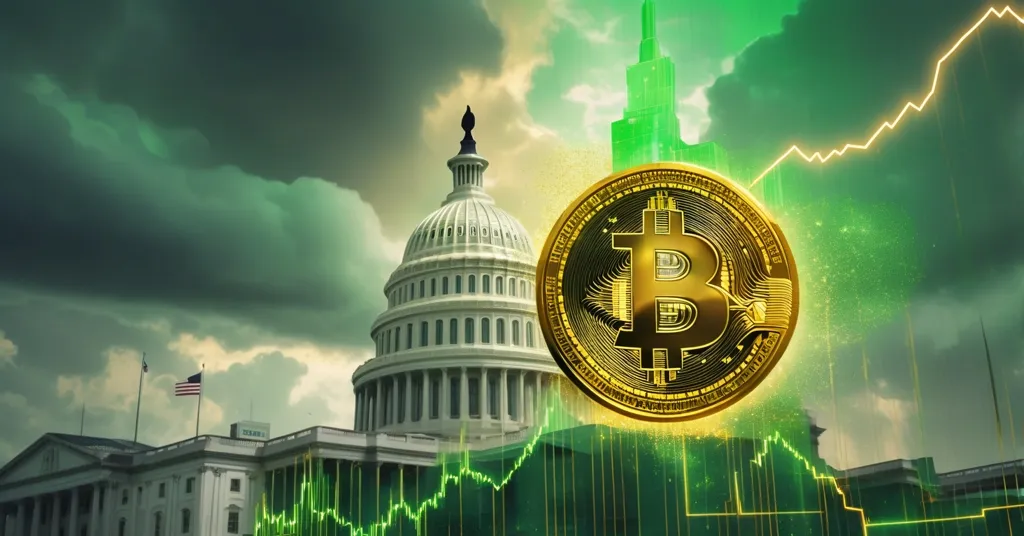Bitcoin Holds at $105K as US Shutdown Deal Fuels Stock Rally and Crypto Optimism

Asia Markets Open: Bitcoin Stands Firm at $105K as US Shutdown Deal Sparks Stock Rally
Bitcoin is holding its ground at $105,373 in early Asian trading on Tuesday, down just 0.9%, while global stocks and gold surge on news that the longest US government shutdown in history—over 40 days—might finally end. With macro relief on the horizon and regulatory clarity emerging, can Bitcoin ride this wave, or is it stuck teasing a breakout?
- Bitcoin’s Resilience: Trading at $105,373, down 0.9%, showing grit amid global shifts.
- US Shutdown Breakthrough: Senate passes funding deal 60-40; House vote and Trump’s signature pending.
- Market Mood: Risk-on sentiment lifts stocks and gold, with potential upside for crypto.
Bitcoin and Crypto Markets: Steady Amid the Noise
As Asian markets kicked off Tuesday, Bitcoin, the heavyweight of cryptocurrencies, clung to a tight range despite a slight dip to $105,373. This price point—a far cry from its $69K peak in 2021 or $20K lows in 2022—reflects a market fueled by retail fervor and institutional muscle since ETF approvals in early 2024. Ethereum, the second-largest crypto by market cap and the backbone of decentralized apps, sat at $3,548, down 1.4%. Meanwhile, XRP, often tied to Ripple’s fast cross-border payment tech, gained 1.4% to $2.48. The total crypto market cap hovered at $3.64 trillion, off by 0.7%, signaling a sector that’s neither collapsing nor exploding—just watching and waiting.
Bitcoin’s current steadiness is noteworthy, especially as it’s often called a high-beta macro asset, meaning its price swings tend to overreact to broader economic trends compared to traditional investments. If global optimism holds, Bitcoin could test a key resistance zone—a price range between $107,000 and $111,000 where selling pressure often halts upward momentum. Break through that, and we might see a rally ripple across digital assets. But let’s not kid ourselves: a pullback to, say, $90K isn’t off the table if macro winds shift or the hype fizzles.
US Shutdown Deal: A Catalyst for Risk Appetite
While Bitcoin holds tough in Asia, the real spark for its next move might be brewing in Washington. The US Senate voted with a decisive majority to pass a funding deal, ending a government shutdown that’s dragged on for over 40 days—the longest in US history. This deal promises long-term federal funding, back pay for workers, food assistance, and healthcare subsidies. Now, it’s up to the House of Representatives, with a vote expected soon, and President Trump’s signature to finalize it. House Speaker Mike Johnson is pushing hard for quick resolution to get federal operations back on track. For more details on the market reactions, check out the latest updates on Bitcoin’s performance and the US shutdown deal.
For the uninitiated, a government shutdown happens when Congress can’t agree on funding, grinding non-essential services to a halt and often rattling markets with uncertainty. The ripple effects of this potential resolution are already hitting traditional markets. South Korea’s Kospi index soared 1.3%, Japan’s Nikkei crept up 0.4%, though Hong Kong and mainland China edged lower with cautious vibes. Across the pond, the Nasdaq jumped 2.3%, powered by a 5.8% surge in NVIDIA stock, and gold—a classic safe haven—rocketed nearly 3% to above $4,100. Riya Sehgal, research analyst at Delta Exchange, nailed the vibe:
“Global risk appetite surged today as US equities rallied, led by NVIDIA’s 5.8% jump, its largest daily gain since April.”
This risk-on mood, where investors ditch safe bets like bonds for growth plays, has a sneaky but real impact on crypto. With fiscal stress easing in the US, Bitcoin and its peers could see fresh interest, especially from big-money players who treat it as a speculative bet or a middle finger to creaky financial systems.
Regulatory Winds: Clarity or Control for Crypto?
Beyond fiscal drama, the crypto space is getting a regulatory facelift in the US that could shape its future. A bipartisan draft in the Senate Agriculture Committee wants to give the Commodity Futures Trading Commission (CFTC) clearer power over digital commodities—think cryptocurrencies treated like raw goods or futures, not investment contracts, under US law. This could cut through the fog of uncertainty for exchanges and projects, setting rules for trading and oversight. Meanwhile, the Internal Revenue Service (IRS) dropped new guidance letting crypto ETFs and trusts earn staking rewards—where you lock up coins to support a blockchain and get paid for it. This is huge for mainstream adoption, as ETFs are a low-risk entry for traditional investors wary of holding crypto directly.
Gracy Chen, CEO of Bitget, summed up the upside:
“Together, these developments signal a maturing regulatory landscape, one that encourages innovation without stifling growth, fostering greater predictability and trust across digital asset markets.”
Let’s pump the brakes, though. Clearer rules sound great, but they could morph into a straitjacket. Overregulation might burden smaller projects or exchanges with compliance costs, potentially choking the decentralized ethos we’re fighting for. And while ETF staking rewards lure institutional cash, they could centralize control in a few big funds, diluting the peer-to-peer vision Satoshi laid out. Plus, if the shutdown deal flops at the last hurdle—say, a House vote stalls—false hope could sour risk sentiment faster than a rug pull in a shady altcoin. We’re all for effective accelerationism, pushing crypto as a disruptive force, but not at the cost of becoming just another cog in the legacy machine.
Altcoins and Ecosystem Strength: Beyond Bitcoin
While Bitcoin maximalists—those who see BTC as the only true crypto—might scoff at the competition, altcoins like Ethereum and XRP play vital roles that Bitcoin isn’t built for. Ethereum’s smart contracts power decentralized finance (DeFi), letting users borrow, lend, or trade without banks, driving innovations Bitcoin can’t touch as a pure store of value. XRP, meanwhile, targets faster, cheaper cross-border payments, a niche where Bitcoin’s slow transaction speeds and high fees fall short. This diversity isn’t dilution; it’s strength, building a broader ecosystem where decentralized tech can challenge centralized giants on multiple fronts. Sure, Bitcoin leads the charge, but ignoring altcoins is like betting on a one-trick pony in a rodeo full of wildcards.
The Bigger Picture: Decentralization in a Messy World
Zooming out, Bitcoin’s quiet defiance at $105K while the world untangles its fiscal knots is a subtle jab at centralized systems. Every step toward macro stability or sane regulation is a chance to accelerate adoption, to prove that freedom and privacy in finance aren’t pipe dreams but real, messy fights worth having. Yet challenges lurk—Federal Reserve rate hikes could tank risk assets, including crypto, and regulatory “clarity” might just mean tighter leashes. And let’s be brutally honest: anyone screaming about Bitcoin hitting $200K next week is peddling predatory garbage. That’s not analysis; it’s grifting. Ignore the noise and focus on the signal: stability opens doors, but volatility is crypto’s middle name.
For investors, Bitcoin’s current grind signals a wait-and-see moment. Keep an eye on the US House vote and Fed whispers before making big moves. The shutdown saga might be winding down, but the battle for a freer financial future is just getting started. We’re bullish on decentralization disrupting the status quo, but let’s not drink the Kool-Aid—real progress demands clear heads and sharp scrutiny.
Key Takeaways and Questions
- How does the US government shutdown resolution impact Bitcoin?
It reduces fiscal uncertainty, boosting risk-on sentiment that can lift high-beta assets like Bitcoin with renewed investor confidence. - What regulatory updates are shaping crypto markets?
CFTC may gain authority over digital commodities, and IRS allows staking rewards for ETFs, enhancing trust and institutional appeal. - Why is Bitcoin seen as a high-beta macro asset?
Its price often exaggerates economic shifts, so positive news like the shutdown deal can spur Bitcoin’s speculative allure. - Can Bitcoin push past its resistance levels soon?
Analysts eye $107,000-$111,000 as a breakout zone; macro relief and momentum could drive a wider crypto rally. - Should crypto investors care about US fiscal policy?
Absolutely—Bitcoin’s ties to global finance mean shutdowns or Fed moves can sway prices and risk appetite significantly.



